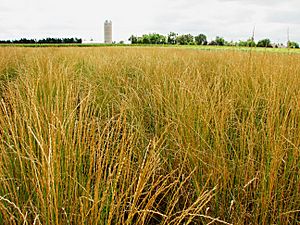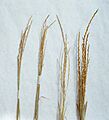Thinopyrum intermedium facts for kids
Quick facts for kids Thinopyrum intermedium |
|
|---|---|
 |
|
| Scientific classification | |
| Genus: |
Thinopyrum
|
| Species: |
intermedium
|
Thinopyrum intermedium, also known as intermediate wheatgrass, is a special type of grass. It grows in clumps and lives for many years. This grass is originally from Europe and Western Asia. It's called "wheatgrass" because its seed heads look a bit like regular wheat. But unlike wheat, which lives for only one year, intermediate wheatgrass comes back year after year! It has even won an award called the Royal Horticultural Society's Award of Garden Merit.
Scientists are studying intermediate wheatgrass as a "multi-purpose" crop. This means it can give us different products and also help the environment. For example, regular crops like corn can make the soil less healthy over time. But perennial grains like intermediate wheatgrass can actually help build up healthy soil while still growing food. The grain from this plant is even trademarked as "Kernza" by The Land Institute.
Contents
Different Names for Intermediate Wheatgrass
Scientific Names
Scientists have given Thinopyrum intermedium many different names over time. These names often change based on how the plant looks. For example, some names depend on whether the plant has tiny hairs or not. Here are a few of the older scientific names for Thinopyrum intermedium:
- Agropyron glaucum
- Elymus hispidus
- Elytrigia intermedia
Common Names
In the United States, intermediate wheatgrass is the most common name for this plant. The word "intermediate" likely refers to its height. It's usually shorter than another type of wheatgrass called "tall wheatgrass."
Another name, wild triga, was given by researchers at The Rodale Institute. They used this name to tell apart the types of intermediate wheatgrass grown for grain from those grown for animal food.
Kernza is a special name. It's a trademarked name used by The Land Institute for the processed grains of intermediate wheatgrass.
Where It Comes From and Where It Grows
Intermediate wheatgrass naturally grows across central and southeastern Europe, reaching into Asia Minor. It was first brought to the United States in 1907. However, it really started to grow well in the U.S. after a successful introduction from the Caucasus region in 1932. Now, you can find it growing wild in many parts of the Western United States and Western Canada.
This plant grows best in certain conditions:
- Areas that get about 12 to 30 inches (30 to 76 cm) of rain each year.
- Soil with a pH level between 5.6 and 8.4.
- Places that get lots of sunshine.
- Soils that are at least 16 inches (41 cm) deep.
- Locations where the temperature doesn't usually drop below -38°F (-39°C).
How We Use Intermediate Wheatgrass
Forage for Animals
Intermediate wheatgrass is a very good plant for feeding animals in the western United States. It grows well with alfalfa, making a good mix for animal food. This plant grows back slowly after being eaten or cut. So, it's best to harvest it only once a year. If you manage it carefully, a field of this grass can last for up to 50 years!
Wildlife Habitat
This grass is also great for wildlife. It provides an excellent food source for animals that graze (eat grass) and browse (eat leaves and twigs). If the grass is not harvested, it makes a good place for some birds and waterfowl to build their nests. Generally, it doesn't spread too much and gets along well with other native plants.
Helping the Soil
Intermediate wheatgrass is also used to help manage soil. It can prevent erosion (when soil is washed away) and help fix land that has been damaged. It quickly grows a strong mat of roots and rhizomes (underground stems). This helps hold the soil in place, even in areas damaged by digging or mining. Within five years, this grass can produce a lot of dry root mass. These roots help keep the soil in place and make it healthier by adding soil carbon.
Grain for Food
Thinopyrum intermedium is a perennial grain crop. In 1983, a research center looked at nearly 100 types of perennial grasses. They wanted to find ones that could be grown for grain. Intermediate wheatgrass was chosen as the most promising. This was because of its good taste, large seeds, and how easy it was to harvest. It also resisted breaking apart or falling over.
The grain from intermediate wheatgrass is similar to regular wheat in terms of nutrition. It can be ground into flour and used to make many foods. These include muffins, tortillas, pancakes, cookies, crackers, bread, beer, and even whisky. Some products made from this grain are sold under the name Kernza.
Producing Seeds
Even though intermediate wheatgrass is mostly used for animal food, producing its seeds is very important. Farmers need these seeds to plant new fields of the grass. In 1988, over 500 metric tons (551 short tons) of seed were harvested in Saskatchewan, Canada, alone. Today, the harvest is a bit smaller. On average, fields produce about 330 pounds per acre (370 kg/ha) of seed. However, some farms have gotten up to 880 pounds per acre (986 kg/ha)!
Seeds are usually grown in rows that are 30 to 36 inches (76 to 91 cm) apart. These wide rows help the plants produce seeds for five to ten years. If the rows are too close, the plants become too dense, and seed yields drop quickly. Even so, the seeds of Thinopyrum intermedium are still quite small compared to wheat.
Breeding for Better Grain
Scientists have been trying to make intermediate wheatgrass even better for grain production. They started evaluating different types of the plant in 1983. They picked the best ones based on how much grain they produced and the quality of the seeds. These best plants were then allowed to breed together. This process is called "mass selection." It means choosing the best plants to create the next generation.
In 2001, seeds from these early breeding efforts were planted at The Land Institute. Scientists carefully selected plants with the highest yield and largest seeds. They continued this process, planting new generations and selecting the best plants each time.
These selection methods have helped increase seed size and yield by about 10 to 18% in each cycle. Scientists also found two important traits. One trait makes the plants shorter, about 12 inches (30 cm) less than wild plants. The other trait changes the shape of the seed head, making it thicker and less likely to break. Both of these traits seem to be controlled by strong genes.
Even with these improvements, the yield of intermediate wheatgrass is still much lower than traditional wheat. Because of this, some researchers are also trying to mix intermediate wheatgrass with wheat.
Mixing with Wheat (Hybridization)
Scientists have also tried to mix Thinopyrum intermedium with wheat. This is called hybridization. It has some big benefits. One main reason is to give regular wheat plants resistance to diseases like fungus. Thinopyrum intermedium has genes that can protect against leaf rust and powdery mildew. It also seems to resist other problems like wheat streak mosaic virus. These genes can help wheat grow better and stronger, especially when conditions are tough.
Another benefit is that Thinopyrum intermedium has genes that can make bread better when mixed with common wheat. Better bread can mean more food for people. Also, bread that stays fresh longer can help feed more people or be sent to places that need food.
Ways to Make It a Better Crop
The Land Institute has been working since 2001 to create good hybrids of wheat and Thinopyrum intermedium. Some successful mixes have been made. These hybrids grow better and are more resistant to problems than either parent plant alone. However, a common problem is that these hybrids often lose the ability to live for many years. They become annuals, like regular wheat.
But, some mixes between durum wheat and Thinopyrum intermedium have kept the perennial trait. They also show other good qualities like being stronger, hardier in cold weather, and having good yields.
There are three main ways scientists are trying to make Thinopyrum intermedium a better grain crop:
- Make Thinopyrum intermedium more like wheat: This means using breeding to make Thinopyrum intermedium seeds bigger and yield more grain. But it would still keep its natural strengths, like being tough and living for many years.
- Make wheat more like Thinopyrum intermedium: This involves mixing wheat with Thinopyrum intermedium. The goal is to give wheat the resistance and perennial traits of Thinopyrum intermedium, while keeping wheat's large seed size and high yield. Scientists hope these two strategies will eventually meet in the middle.
- Use what we know about other crops: Scientists are studying how other grasses like wheat and barley became domesticated. They are looking for similar genes in Thinopyrum intermedium. If they can find these "domestication genes," they might be able to change them using new breeding methods. This could speed up the process of making Thinopyrum intermedium a great grain crop.
Images for kids













